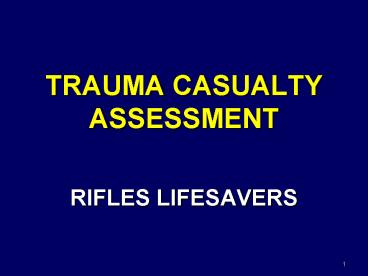TRAUMA CASUALTY ASSESSMENT PowerPoint PPT Presentation
1 / 15
Title: TRAUMA CASUALTY ASSESSMENT
1
TRAUMA CASUALTY ASSESSMENT
- RIFLES LIFESAVERS
2
Tactical Combat Casualty Care
- Care Under Fire
- The best medicine on any battlefield is fire
superiority - Minimal casualty assessment
- Immediate treatment of extremity hemorrhage
- Tactical Field Care
- Rapid trauma assessment and immediate treatment
of life-threatening injuries - More detailed trauma assessment and stabilization
of non life-threatening injuries - Casualty Evacuation Care
- Continual casualty assessment
3
Scene Assessment
- Determine safety of scene
- Determine mechanism of injury
- Determine number of casualties
- Request additional help if necessary
4
Primary Assessment ABCDE
- Communicate verbally with casualty
- Helps establish immediate status of airway,
breathing, circulation, and mental status - Airway
- Breathing
- Circulation
- Disability (Neurologic status)
- Exposure
5
IMPORTANT!
- When life-threatening injuries are encountered
during the primary assessment, stop and perform
the necessary life-saving procedure before
proceeding - Failure to do so may result in an otherwise
preventable death
6
Airway
- Attention to manual stabilization of cervical
spine if appropriate - Airway obstructions are often noisy (but not
always) - Suspect airway problems
- Unconscious
- Head, face, neck, chest injuries
- Open, clear, and maintain the airway
7
Breathing
- Look, listen, and feel
- If chest injury and severe difficulty breathing,
perform needle chest decompression to relieve
tension pneumothorax
8
Circulation
- Look for severe external bleeding
- STOP THE BLEEDING!
- Direct pressure
- Pressure points
- Tourniquet
- Assess for internal bleeding
- Check pulses
- Observe for shock
- Initiate IV fluids
9
Disability (Neurologic Status)
- Level of consciousness using AVPU scale
- Alert Converses spontaneously and appropriately
- Verbal Responds to verbal stimuli
- Painful Responds to painful stimuli
- Unresponsive Unresponsive to any stimuli
- Pupil size
- Pupils should be equal and constrict vigorously
to light stimulus - Motor function
- Strength should be normal and equal in all
extremities
10
Exposure
- Remove clothing to expose area of injury
- Do not delay resuscitation to expose injuries
- Keep casualty covered after exposure to avoid
hypothermia due to blood loss
11
Conditions that Require Immediate Transport
- Poor general condition
- Unresponsive
- Responsive but does not follow commands
- Difficulty breathing
- Uncontrolled breathing
- Severe pain
12
Secondary Trauma Assessment
- Deformities
- Contusions
- Abrasions
- Penetrating injuries
- Burns
- Tenderness
- Lacerations
- Swelling
- Perform more detailed exam of body areas with
attention to DCAP-BTLS
13
Secondary Trauma Assessment Head to Toe
- Head
- Neck
- Apply cervical collar if unconscious or midline
spinal tenderness - Chest
- Abdomen
- Pelvis
- Extremities
- Back
- Log roll casualty to stabilize spine
14
Prepare to Evacuate
15
Questions?

